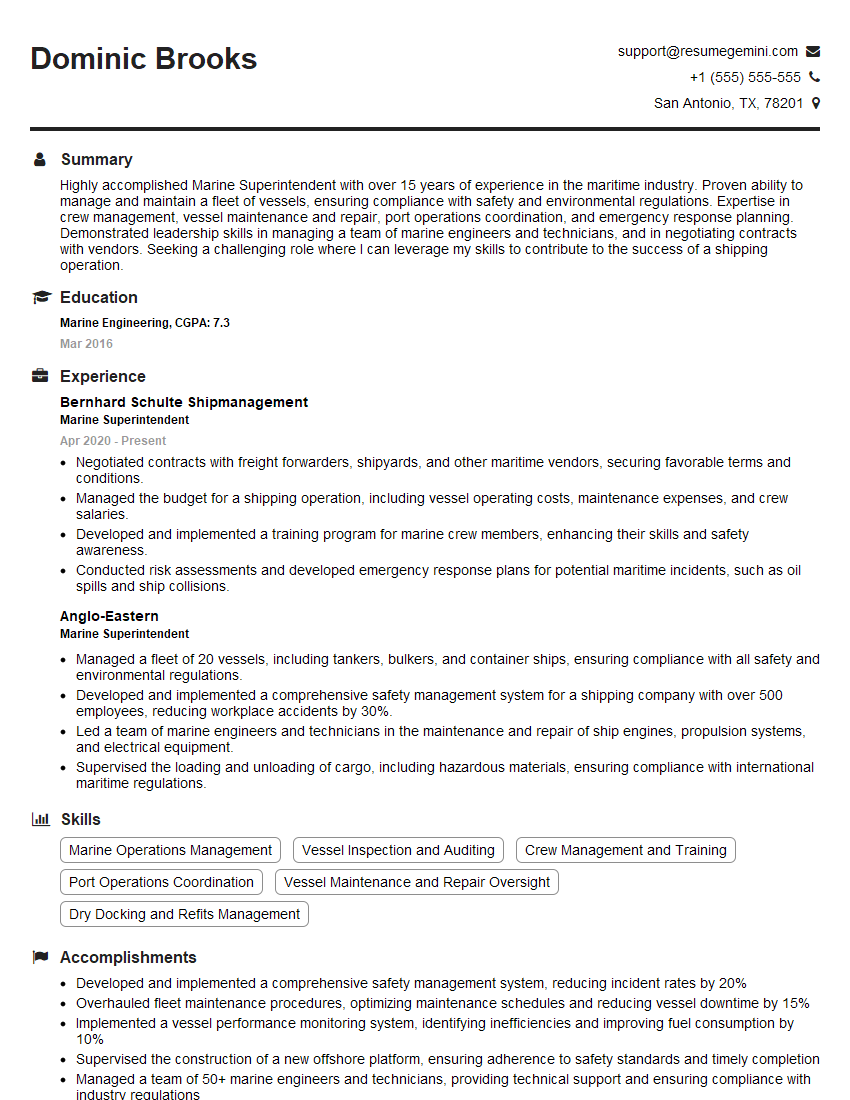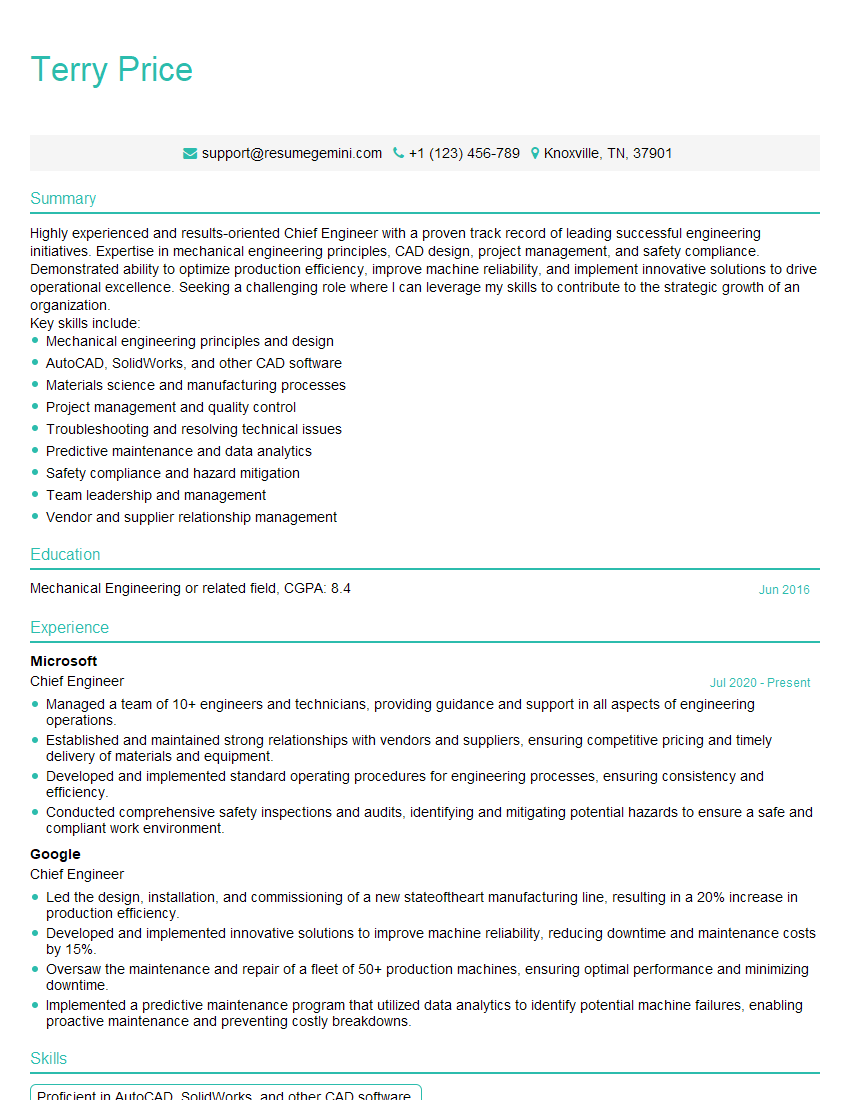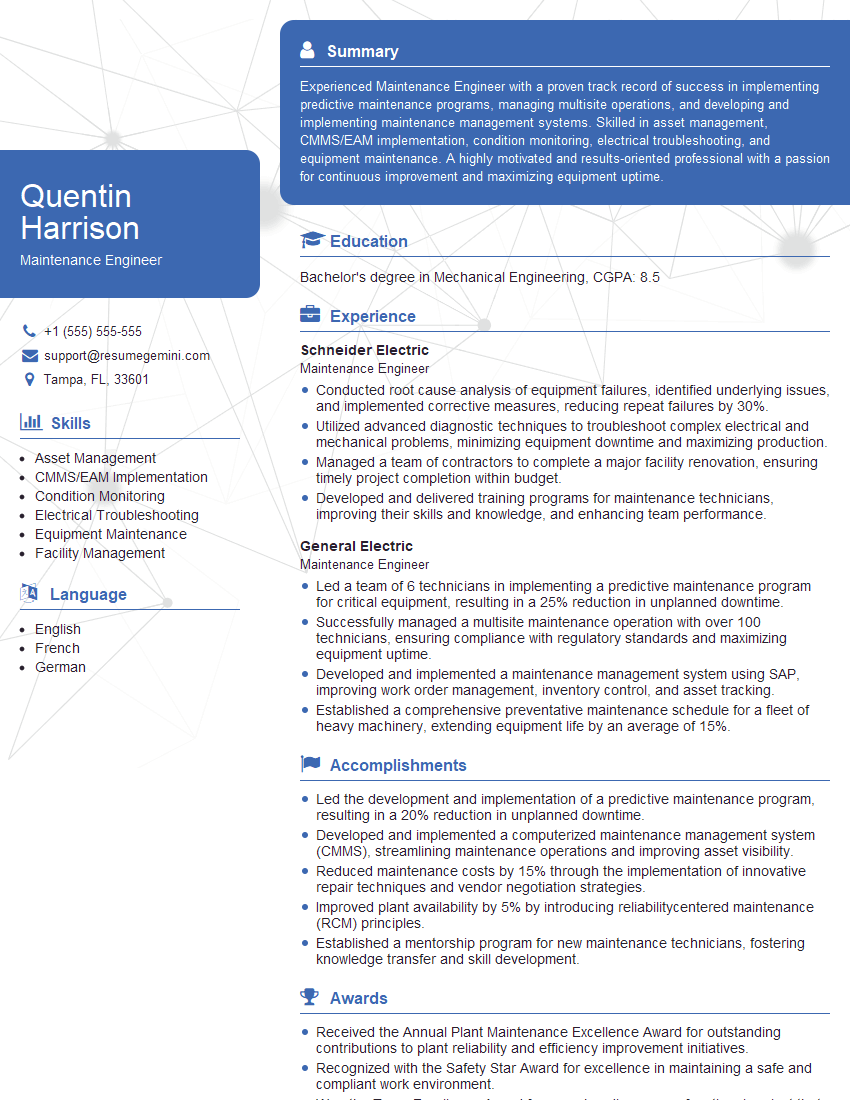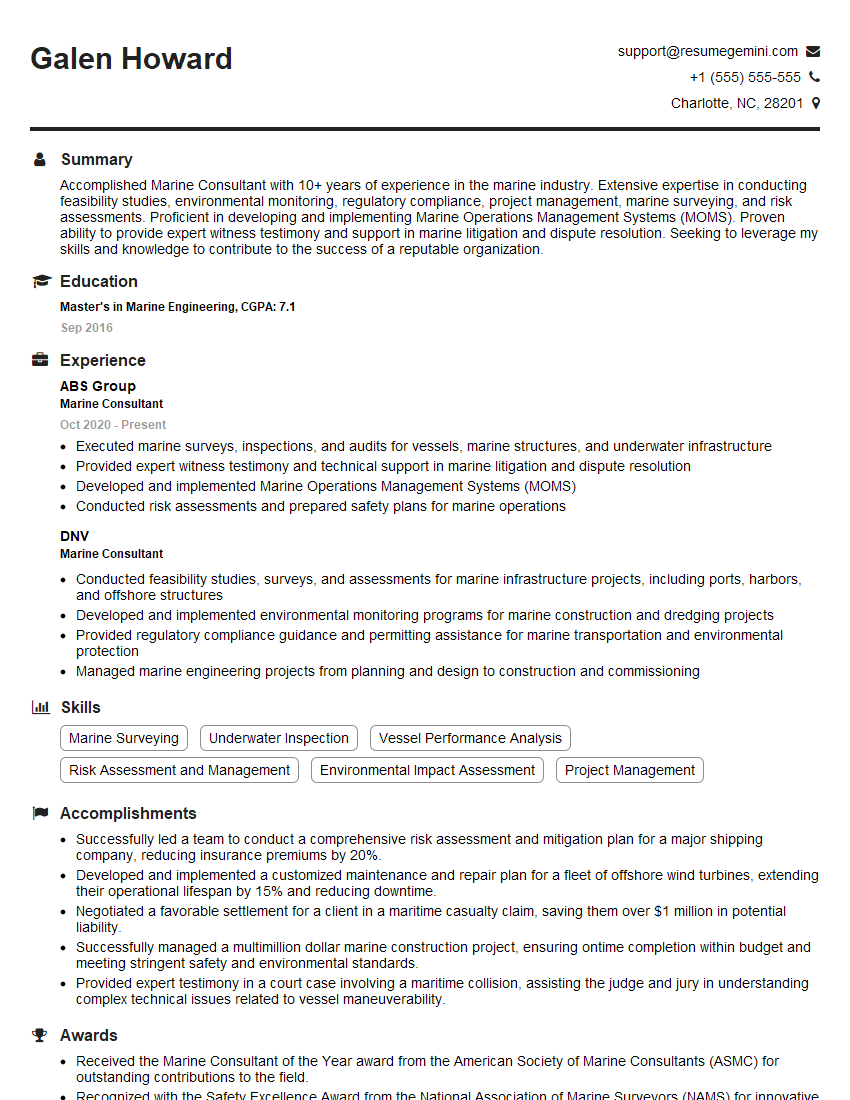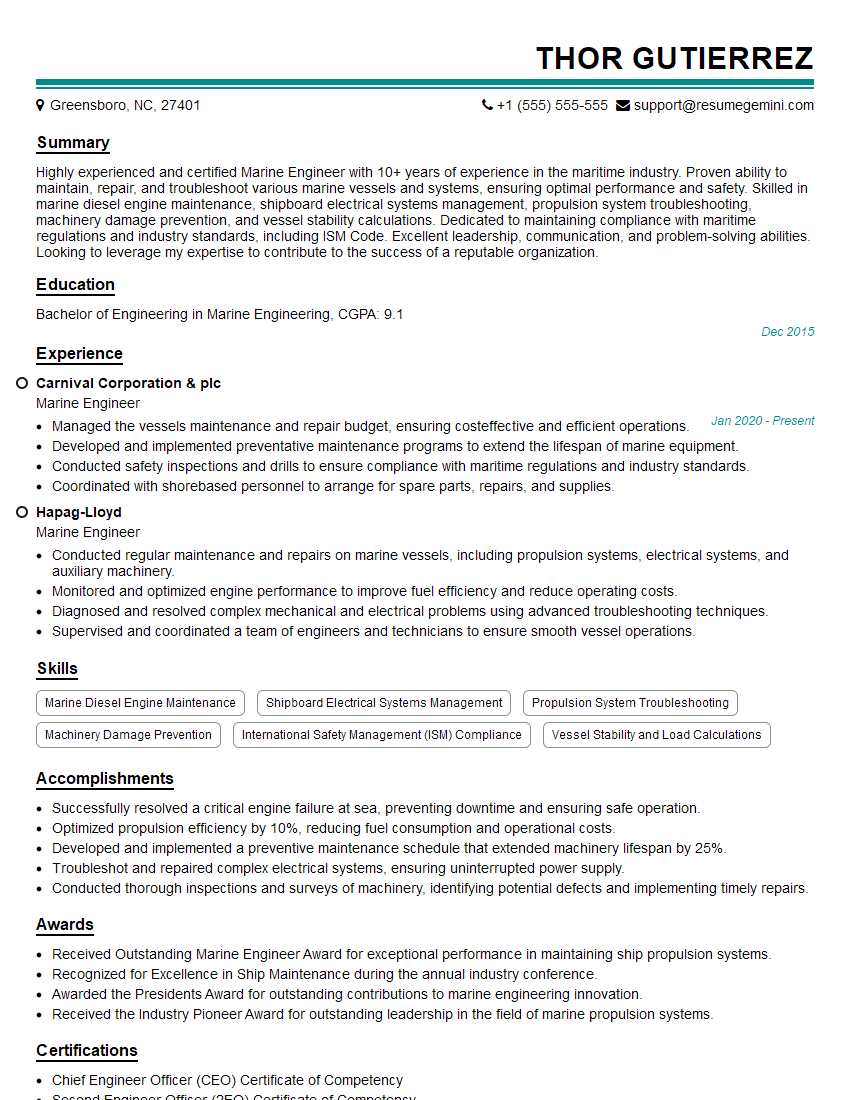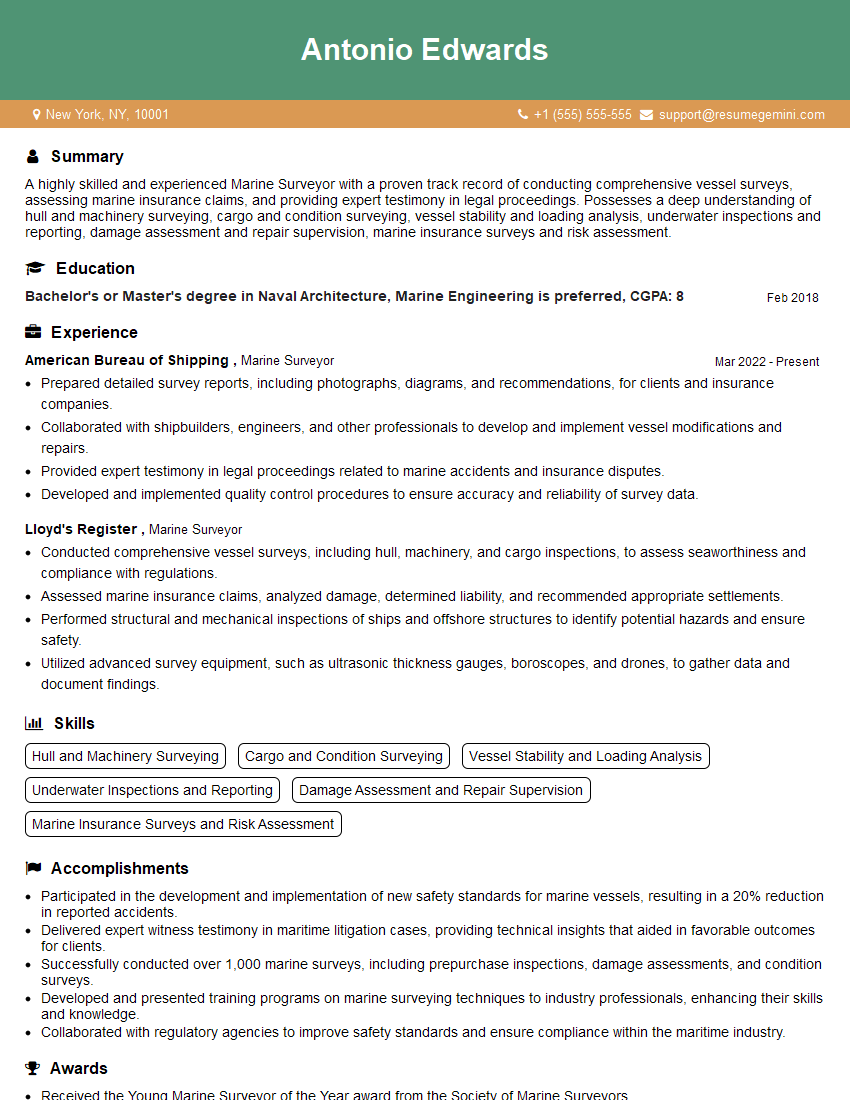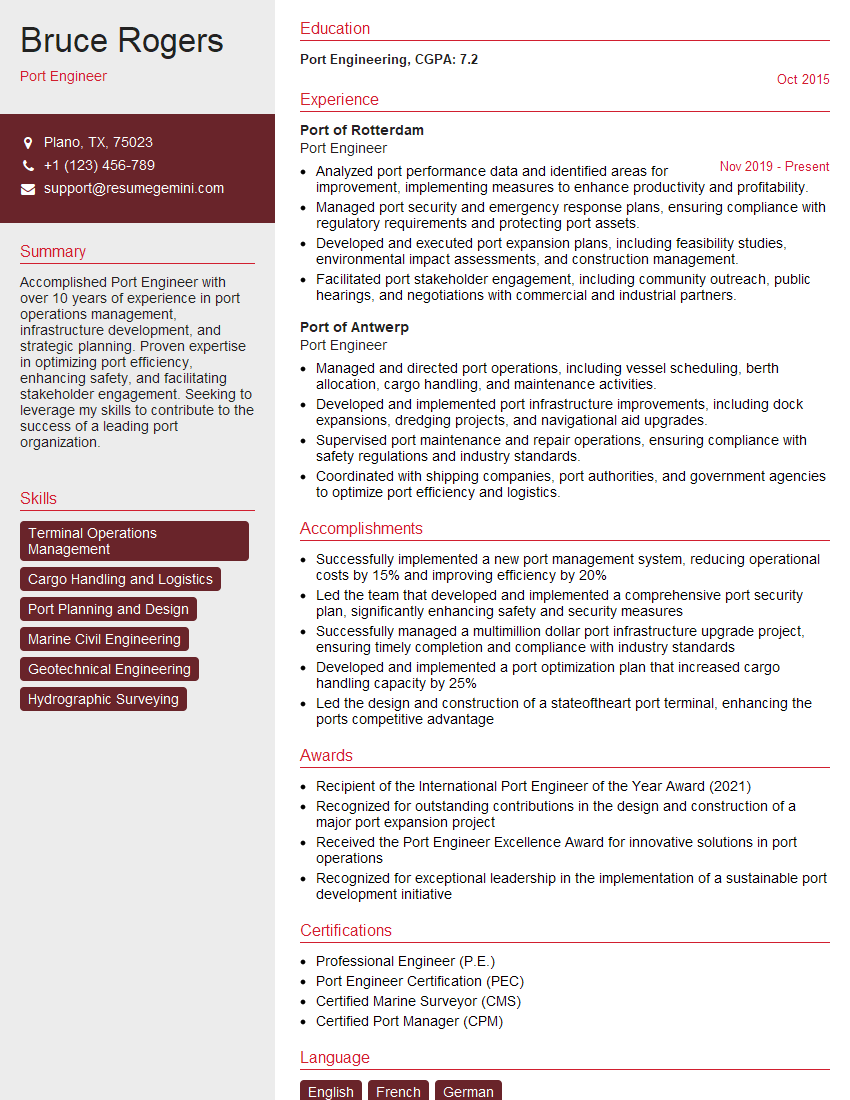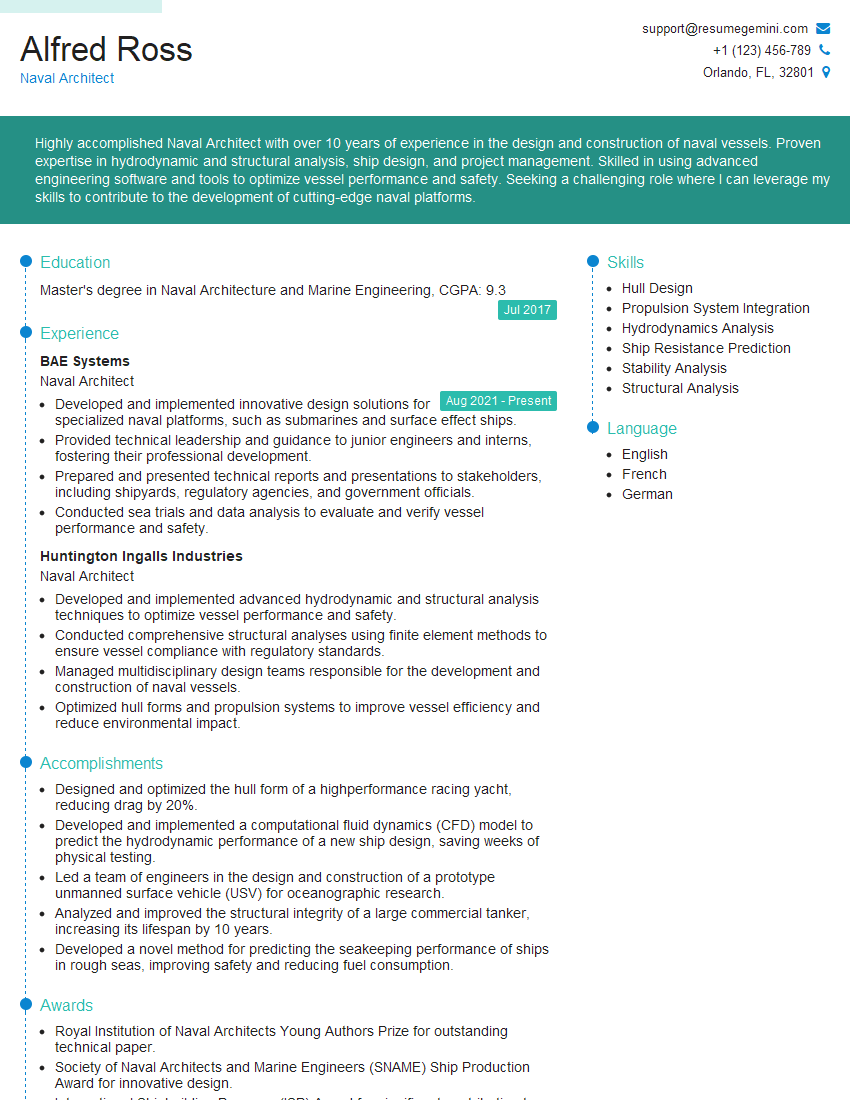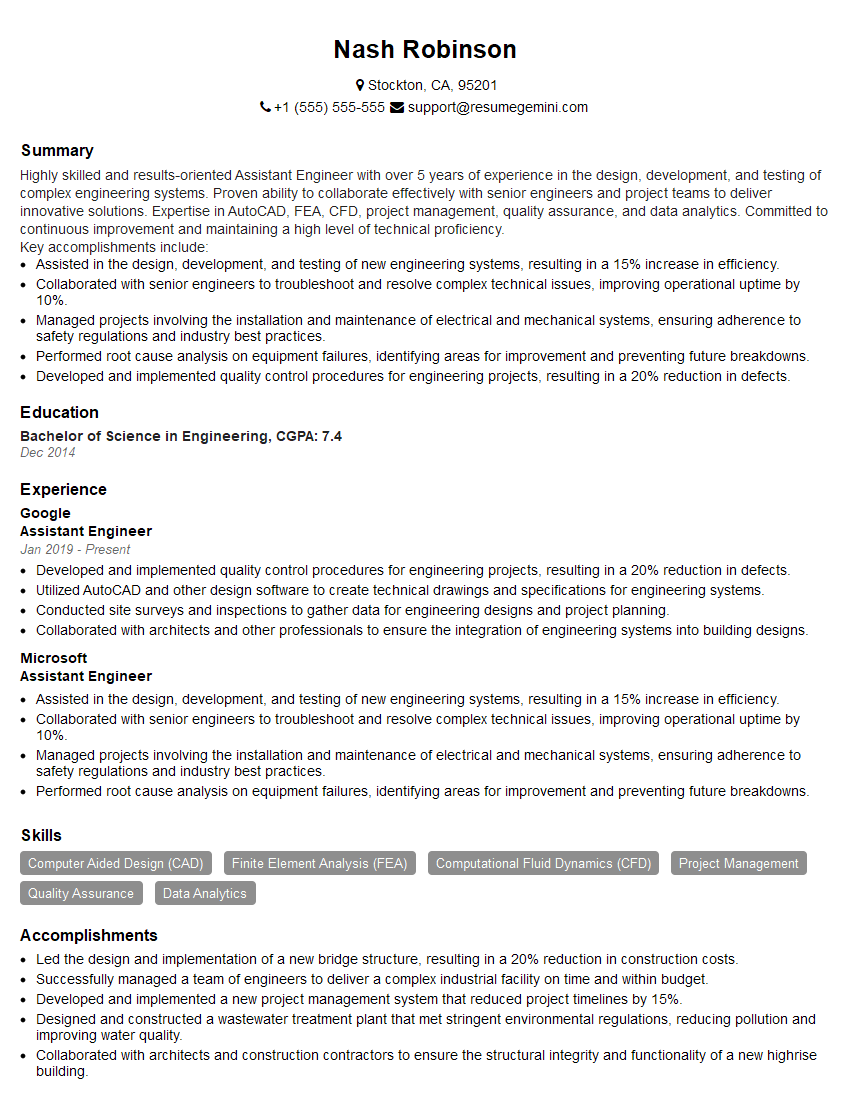Are you ready to stand out in your next interview? Understanding and preparing for Knowledge of Marine Engineering interview questions is a game-changer. In this blog, we’ve compiled key questions and expert advice to help you showcase your skills with confidence and precision. Let’s get started on your journey to acing the interview.
Questions Asked in Knowledge of Marine Engineering Interview
Q 1. Explain the principles of a four-stroke diesel engine.
A four-stroke diesel engine operates through four distinct piston strokes: intake, compression, power, and exhaust. Think of it like a four-part cycle that converts fuel into mechanical energy.
Intake Stroke: The piston moves downwards, drawing in air into the cylinder. Imagine a vacuum cleaner sucking in air.
Compression Stroke: The piston moves upwards, compressing the air to a high temperature and pressure. This is like squeezing a balloon – the air inside gets hotter and more compact.
Power Stroke: Fuel is injected into the highly compressed air, causing ignition and a powerful expansion of gases. This forceful expansion pushes the piston downwards, creating the power that drives the engine. This is like a tiny controlled explosion.
Exhaust Stroke: The piston moves upwards again, pushing the spent exhaust gases out of the cylinder. This is like clearing the chamber after the explosion.
This entire cycle repeats continuously for each cylinder, generating rotational force to power the vessel’s propeller.
Q 2. Describe the different types of marine propulsion systems.
Marine propulsion systems vary depending on vessel size, speed, and operational requirements. Common types include:
Diesel Engines: The workhorse of many ships, ranging from small, slow-speed engines to large, high-powered ones driving propellers directly or through gears.
Gas Turbines: High-speed engines used for fast ships and naval vessels, known for their high power-to-weight ratio. They often complement diesel engines in combined cycle systems.
Electric Propulsion: Growing in popularity, this involves electric motors driving propellers, often powered by diesel generators or other prime movers. This allows for greater efficiency and control.
Waterjets: High-speed propulsion systems that use powerful pumps to propel water through nozzles, creating thrust. They’re excellent for shallow-draft vessels.
Podded Propulsion: Enclosed propulsors that rotate 360 degrees, offering improved maneuverability and efficiency. Think of them as highly sophisticated, steerable thrusters.
The choice of propulsion system is critical to a vessel’s overall performance and efficiency.
Q 3. What are the main components of a marine boiler?
A marine boiler is essentially a large pressure vessel that generates steam. Key components include:
Furnace: Where fuel (oil or gas) is burned to produce heat.
Combustion Chamber: The space where the fuel-air mixture burns.
Water Walls/Heating Surfaces: Surfaces where water absorbs the heat generated by combustion, producing steam.
Superheater: Heats the steam to even higher temperatures for improved efficiency.
Economizer: Preheats the feedwater using the exhaust gases, increasing efficiency and reducing fuel consumption.
Steam Drum: Collects and stores the generated steam.
Safety Valves: Essential safety devices that release excess pressure to prevent explosions.
These components work together in a controlled process to generate steam for various shipboard systems.
Q 4. Explain the process of maintaining a marine engine.
Maintaining a marine engine is a rigorous process involving regular inspections, servicing, and preventative measures. It involves:
Regular Inspections: Visual checks, oil analysis, and vibration monitoring to detect potential problems early on. Think of it as a regular medical checkup for the engine.
Scheduled Overhauls: Major servicing events involving disassembly, cleaning, inspection, and repair or replacement of parts. This is like a complete engine tune-up.
Lubrication: Ensuring proper lubrication of moving parts using appropriate oils and greases is paramount. Think of oil as the engine’s lifeblood.
Fuel System Maintenance: Cleaning fuel tanks, filters, and injectors to ensure clean fuel supply. This prevents clogging and ensures efficient combustion.
Cooling System Maintenance: Checking coolant levels, cleanliness, and ensuring proper cooling water flow. This prevents overheating and damage to the engine.
Proper maintenance ensures optimal performance, longevity, and safety of the engine and the vessel.
Q 5. How do you troubleshoot engine malfunctions?
Troubleshooting engine malfunctions is systematic. It involves:
Gather Information: Identify the symptom(s) – loss of power, unusual noises, smoke, alarms, etc.
Check Vital Signs: Assess engine parameters – oil pressure, temperature, fuel pressure, RPMs.
Consult Logs and Records: Review recent maintenance records and operational data.
Visual Inspection: Examine the engine and its components for any visible damage or leaks.
Systematic Checks: Check related systems like fuel, lubrication, cooling, and exhaust. Use a methodical approach, eliminating possibilities one by one.
Use Diagnostic Tools: Employ engine diagnostic tools to pinpoint specific problems.
Remember, safety is paramount. If unsure about a problem, consult experienced engineers before attempting repairs.
Q 6. Describe your experience with engine room automation systems.
I have extensive experience with engine room automation systems, including those using programmable logic controllers (PLCs) and distributed control systems (DCSs). I am proficient in monitoring systems, alarm management, data logging, and remote diagnostics. For example, in my previous role, I was involved in the upgrade of a vessel’s automation system, which significantly improved efficiency and reduced human error. This included programming the PLC to optimize engine performance and integrating the system with the vessel’s central monitoring station. I’m familiar with various protocols like Profibus and Modbus, used in communication between different components of the system. Furthermore, I understand the importance of cybersecurity within these systems and best practices for ensuring their integrity and reliability.
Q 7. What is your experience with marine refrigeration systems?
My experience with marine refrigeration systems encompasses both air conditioning and cargo refrigeration. I am familiar with various refrigerant types, compressor technologies, and control systems. I have been involved in troubleshooting and maintenance of refrigeration systems on several vessels, including diagnosing and repairing compressor failures, resolving refrigerant leaks, and optimizing system performance for energy efficiency. I understand the regulations and safety precautions associated with handling refrigerants and ensuring the proper functioning of these systems for maintaining optimal cargo temperatures or crew comfort. For instance, I once successfully resolved a significant refrigerant leak in a cargo refrigeration system, preventing substantial cargo loss and maintaining operational standards.
Q 8. Explain the principles of marine HVAC systems.
Marine HVAC (Heating, Ventilation, and Air Conditioning) systems are crucial for maintaining comfortable and safe conditions onboard vessels. They operate on principles similar to land-based systems but with added complexities due to the marine environment – exposure to saltwater, vibration, and space constraints. The core principles involve:
- Refrigeration Cycle: Most systems utilize a vapor-compression refrigeration cycle. A refrigerant absorbs heat from the conditioned space, is compressed, releases heat to the outside, and then expands, repeating the cycle. This is similar to your home refrigerator, just on a larger scale and adapted for marine use.
- Air Handling: Fans and ductwork distribute conditioned air throughout the ship. Careful design is crucial to ensure even temperature distribution across different zones, accounting for the unique airflow challenges of a ship’s structure.
- Heat Exchangers: These transfer heat between the refrigerant and seawater or other cooling media. Efficient heat exchangers are essential for optimal performance and reduced energy consumption. Different types, like plate heat exchangers or shell-and-tube heat exchangers, are chosen depending on the application and space availability.
- Controls: Sophisticated control systems, often automated, monitor temperature, humidity, and airflow to maintain optimal conditions. These systems incorporate sensors and actuators to adjust the system’s operation based on demand and environmental changes. Think of them as a sophisticated thermostat managing the whole ship’s climate.
- Seawater Cooling: A key difference from land-based systems is the use of seawater for cooling. This requires specialized components resistant to corrosion and fouling. Regular maintenance, including cleaning of the seawater intake strainers, is critical.
For example, in a passenger cruise ship, different zones (cabins, restaurants, public areas) will have independent HVAC zones controlled by a central system, allowing for customized climate control in each area. Maintaining these systems requires skilled engineers familiar with both HVAC principles and the unique demands of a marine environment.
Q 9. How do you ensure compliance with SOLAS regulations?
Ensuring compliance with SOLAS (Safety of Life at Sea) regulations requires a rigorous and proactive approach. This involves several key steps:
- Regular Inspections and Maintenance: All safety-related equipment, including lifeboats, fire-fighting systems, and emergency generators, must undergo regular inspections and maintenance according to a strict schedule outlined in the SOLAS Convention and national regulations. Detailed logs must be kept recording these activities.
- Documentation: Meticulous record-keeping is vital. All inspections, repairs, and maintenance activities must be properly documented, often in dedicated logbooks, providing evidence of compliance during audits.
- Crew Training: The crew must receive regular training on the use and operation of all safety equipment and emergency procedures. This training should be documented, and certificates are frequently required.
- Emergency Drills: Regular emergency drills are mandatory to ensure crew proficiency in handling various emergency scenarios. These drills are observed and documented, allowing for continuous improvement and better emergency preparedness.
- Certification and Surveys: The vessel must undergo regular surveys by authorized bodies to ensure continued compliance with SOLAS regulations. This typically includes inspections by maritime authorities or classification societies (like DNV, ABS, Lloyd’s Register) who issue certificates that confirm the vessel meets the required standards.
Failure to comply with SOLAS can lead to significant penalties, including detention of the vessel and potential legal repercussions. Therefore, maintaining SOLAS compliance is not just a legal requirement but a crucial element in ensuring the safety of the crew and passengers.
Q 10. Describe your experience with marine safety equipment.
My experience encompasses a wide range of marine safety equipment, from life-saving appliances to fire-fighting systems and emergency response tools. I’ve worked extensively with:
- Lifeboats and Liferafts: I’ve participated in regular inspections and maintenance, ensuring their seaworthiness and readiness for deployment. This includes checking davit systems, lifeboat engines, and emergency equipment.
- Fire-Fighting Systems: My experience includes working with various systems such as fixed CO2 systems, sprinkler systems, and foam systems. This involves testing, maintenance, and repairs, ensuring the systems are always functional.
- Personal Protective Equipment (PPE): I’m familiar with all the necessary PPE, including life jackets, immersion suits, and fire-resistant clothing. I ensure proper storage and regular inspection of this equipment.
- Emergency Generators: I have experience maintaining and troubleshooting emergency power generators, crucial for maintaining critical systems during power outages.
- GMDSS (Global Maritime Distress and Safety System) equipment: I have a thorough understanding of its operation and maintenance, including VHF radios, EPIRBs (Emergency Position-Indicating Radio Beacons), and Inmarsat equipment.
On one occasion, during a routine inspection, I discovered a critical fault in a lifeboat’s davit system. Early detection and swift action prevented a potential accident. This highlights the importance of diligent maintenance and thorough inspections in ensuring the effectiveness of safety equipment.
Q 11. Explain the importance of ballast water management.
Ballast water management is critically important for preventing the spread of invasive aquatic species. Ships use ballast water to maintain stability during transit. However, this water often contains organisms that can wreak havoc on the ecosystems of receiving ports. Therefore, effective ballast water management aims to:
- Minimize the introduction of non-native species: This involves various treatment methods, ranging from simple exchange of ballast water in open ocean to advanced technologies like UV disinfection or filtration systems.
- Comply with international regulations: The International Maritime Organization (IMO) has introduced regulations (the Ballast Water Management Convention) requiring ships to manage their ballast water to prevent the spread of invasive species. Compliance involves installing approved treatment systems and maintaining detailed records of ballast water management activities.
- Protect marine biodiversity: Invasive species can outcompete native organisms, leading to biodiversity loss and ecological damage. Effective ballast water management is crucial for preserving marine ecosystems.
- Prevent economic damage: Invasive species can have significant economic impacts on fisheries, aquaculture, and other industries reliant on healthy marine ecosystems.
Imagine a situation where a ship carrying ballast water from a port in Asia arrives in the Caribbean. If this water contains an invasive species, it could potentially disrupt the local ecosystem, negatively impacting fisheries or tourism. Effective ballast water management prevents such scenarios.
Q 12. What is your experience with marine pollution prevention?
My experience in marine pollution prevention involves a multi-faceted approach focused on minimizing the risk of pollution from a vessel. This includes:
- Oil Pollution Prevention: Regular inspection and maintenance of oil tanks, pipelines, and bilge systems are crucial to prevent oil spills. This includes ensuring the proper functioning of oil water separators and adherence to strict MARPOL (International Convention for the Prevention of Pollution from Ships) regulations.
- Garbage Management: Implementing a robust waste management plan, ensuring proper segregation and disposal of garbage in compliance with MARPOL regulations. This typically involves maintaining detailed garbage records and adhering to strict procedures for overboard discharges.
- Sewage Treatment: Overseeing the proper operation and maintenance of sewage treatment plants to prevent untreated sewage discharge into the sea.
- Cargo Handling Procedures: Implementing strict cargo handling procedures to minimize the risk of cargo spills or leaks.
- Reporting of Incidents: Prompt reporting of any pollution incidents to relevant authorities, ensuring timely response and mitigation of environmental impact.
For instance, during a voyage, I discovered a small leak in an oil tank. By quickly identifying and addressing the leak, we prevented a larger spill and avoided significant environmental and legal repercussions. This illustrates the importance of proactive maintenance and immediate response to any potential pollution event.
Q 13. How do you handle emergency situations in the engine room?
Handling emergency situations in the engine room requires a calm and systematic approach. My response is based on a well-defined emergency response plan, and it involves the following steps:
- Assess the situation: Quickly identify the nature and extent of the emergency. This may involve activating alarms, checking gauges and instruments, and assessing potential hazards.
- Activate emergency procedures: Follow the established emergency procedures, which often include activating fire-fighting systems, shutting down critical equipment, and initiating emergency power systems.
- Contain the situation: Take immediate steps to contain the emergency, preventing its spread or escalation. This might involve isolating the affected area or equipment.
- Notify relevant personnel: Alert the chief engineer, captain, and other relevant personnel to the emergency.
- Implement damage control measures: Take appropriate measures to minimize the damage and mitigate the effects of the emergency. This might include activating pumps to remove water or deploying fire-fighting equipment.
- Post-emergency procedures: After the immediate emergency is resolved, follow post-emergency procedures, which usually involve documenting the incident, assessing the damage, and initiating repairs.
During one emergency, a sudden high-temperature alarm triggered in the main engine. By swiftly following our emergency protocols, including shutting down the affected system and engaging the auxiliary generator, we prevented a major engine failure. Proper training and adherence to established procedures are key to effectively managing engine room emergencies.
Q 14. What are your skills in diagnosing and repairing marine electrical systems?
My skills in diagnosing and repairing marine electrical systems are extensive. This includes troubleshooting and repairing:
- Switchboards and distribution systems: I can diagnose faults in circuit breakers, fuses, and other switchboard components.
- Motors and drives: I have expertise in diagnosing and repairing AC and DC motors, including variable frequency drives (VFDs).
- Wiring and cabling: I’m proficient in tracing and repairing wiring and cable faults, including splicing and terminating cables.
- Lighting and power systems: I can troubleshoot and repair issues with the ship’s lighting systems, emergency lighting systems, and other electrical power systems.
- Instrumentation and control systems: I have experience in troubleshooting and repairing various electronic sensors, instruments, and control systems commonly found on board.
- Navigation and communication equipment: I have basic familiarity with the electrical systems associated with navigation and communication equipment.
For instance, I once successfully diagnosed a complex fault in a ship’s propulsion motor control system, reducing downtime and preventing a significant delay in the vessel’s schedule. My approach involves systematic testing, the use of appropriate diagnostic tools, and thorough understanding of electrical circuits and control systems. Furthermore, I am highly proficient with various types of test equipment used for marine electrical diagnosis such as multimeters, meggers, and clamp meters.
Q 15. Explain your understanding of marine hydraulic systems.
Marine hydraulic systems utilize pressurized fluids, typically oil, to transmit power for various onboard operations. Think of it like a network of veins and arteries, but instead of blood, it’s hydraulic fluid carrying immense power. This power actuates components like steering gears, winches, cranes, and deck machinery. The system comprises several key elements: a hydraulic pump to generate pressure, valves to control fluid flow and direction, actuators (hydraulic cylinders or motors) to convert hydraulic energy into mechanical work, and a reservoir to store the fluid. A critical aspect is the fluid itself, requiring specific properties for optimal performance under varying temperature and pressure conditions. For example, on a large container ship, hydraulics power the massive crane systems used for loading and unloading containers – a task impossible without this efficient power transmission method.
Different types of hydraulic systems exist, including open-centre and closed-centre systems, each with its own advantages and disadvantages based on application and efficiency needs. Understanding these variations is crucial for effective troubleshooting and maintenance.
Career Expert Tips:
- Ace those interviews! Prepare effectively by reviewing the Top 50 Most Common Interview Questions on ResumeGemini.
- Navigate your job search with confidence! Explore a wide range of Career Tips on ResumeGemini. Learn about common challenges and recommendations to overcome them.
- Craft the perfect resume! Master the Art of Resume Writing with ResumeGemini’s guide. Showcase your unique qualifications and achievements effectively.
- Don’t miss out on holiday savings! Build your dream resume with ResumeGemini’s ATS optimized templates.
Q 16. Describe your experience with pneumatic systems on board a vessel.
My experience with pneumatic systems onboard vessels primarily involves smaller applications compared to hydraulics. Pneumatics uses compressed air to power equipment. It’s often preferred for simpler, less powerful operations where high precision isn’t paramount. Onboard, I’ve encountered pneumatic systems used for things like: operating small control valves, actuating air-powered tools in the workshop (e.g., impact wrenches), and even assisting with some aspects of waste disposal systems. Because compressed air is readily available (unlike the need for specialized hydraulic fluid), pneumatic systems offer simplicity and ease of maintenance. However, they’re generally less powerful and efficient than hydraulic systems for heavier-duty tasks.
One specific example is working with the pneumatic system controlling the air vents in a vessel’s accommodation areas. A faulty pressure regulator resulted in inconsistent air flow, and I was able to diagnose the issue and replace the faulty component, restoring proper ventilation.
Q 17. What is your experience with marine piping systems?
My experience with marine piping systems is extensive. I’ve worked with systems carrying various fluids, including seawater, fuel oil, lubricating oil, fresh water, and compressed air. Understanding piping systems goes beyond just knowing what pipe is where. It involves analyzing the flow characteristics of each fluid, pressure ratings of the piping and fittings, material compatibility (to prevent corrosion), and ensuring proper insulation where required. A critical aspect is the identification and prevention of leaks. These can have serious consequences, from environmental damage (oil spills) to safety hazards.
I’m proficient in performing routine inspections, identifying potential leaks or weaknesses in the system, and conducting repairs using appropriate welding and fitting techniques. I also have experience in using specialized tools and techniques for non-destructive testing to ensure piping system integrity without causing damage. This includes procedures like ultrasonic testing to detect internal flaws and pressure testing to identify leaks under pressure.
Q 18. How do you manage the maintenance of onboard machinery?
Maintaining onboard machinery is a multifaceted process involving preventative maintenance, planned maintenance, and corrective maintenance. I utilize a combination of scheduled inspections, condition monitoring, and predictive analysis. Preventative maintenance involves routine checks, cleaning, lubrication, and minor repairs to prevent major failures. Planned maintenance involves scheduled overhauls and replacements according to manufacturers’ recommendations and vessel operational requirements. Corrective maintenance, however, deals with resolving unexpected breakdowns and failures.
A key aspect of my approach is meticulous record-keeping. I document all maintenance activities, including dates, performed work, and any findings. This ensures continuity and allows for effective trend analysis to proactively address potential problems before they become major issues. A thorough understanding of each piece of equipment’s operating parameters and associated safety procedures is essential. For example, before working on any system, I would ensure it is properly isolated and locked out/tagged out to prevent accidents.
Q 19. What are your skills in interpreting engineering drawings and schematics?
Interpreting engineering drawings and schematics is fundamental to my role. I’m proficient in reading various types of drawings, including piping and instrumentation diagrams (P&IDs), general arrangement drawings, and detailed component drawings. I understand the use of symbols, notations, and dimensions to understand the system layout and the interrelationships between different components.
For example, when troubleshooting a hydraulic system failure, I can quickly refer to the P&ID to trace the fluid flow path and identify potential points of failure. Understanding the schematics allows me to effectively plan and execute repairs or maintenance efficiently, minimizing downtime and optimizing resources. My experience extends to the use of computer-aided design (CAD) software for reviewing and updating drawings as needed.
Q 20. Explain your experience with marine fuel management.
Marine fuel management encompasses several aspects, from bunkering (receiving fuel) to storage, distribution, and consumption monitoring. Safe and efficient fuel management is vital for operational safety, economic efficiency, and environmental compliance. My experience includes overseeing bunkering operations, ensuring correct fuel grade and quantity are received and properly documented. I’m familiar with fuel oil testing procedures to verify fuel quality and compliance with international standards. This includes testing parameters such as viscosity, density, and sulfur content.
I also have experience monitoring fuel consumption using onboard systems to detect any anomalies that could indicate potential problems. This requires understanding the vessel’s fuel consumption patterns and adjusting predictions for changing operational conditions. Proper fuel management helps in optimizing fuel efficiency, reducing costs, and minimizing environmental impact by reducing emissions.
Q 21. Describe your knowledge of different types of marine lubricants.
Marine lubricants are crucial for efficient operation and longevity of onboard machinery. Different types of lubricants cater to specific needs and applications. For instance, diesel engine lubricating oils are formulated to withstand high temperatures and pressures, preventing wear and tear on engine components. Gear oils are designed for high-load applications, providing protection against extreme pressures and preventing gear tooth wear. Other types include hydraulic oils (already discussed), compressor oils, and greases for various machinery parts.
Selecting the correct lubricant is critical and depends on the equipment’s operating conditions and manufacturer’s recommendations. Incorrect lubrication can lead to premature wear, equipment damage, and potential breakdowns. Regular oil analysis is essential to monitor lubricant condition, detect potential contamination or degradation, and plan for timely oil changes. I have extensive experience in performing such analysis and interpreting the results to ensure the machinery operates optimally.
Q 22. How do you conduct a pre-voyage inspection of the engine room?
A pre-voyage engine room inspection is crucial for ensuring the safe and efficient operation of the vessel. It’s a systematic check of all vital systems before departure. Think of it like a thorough pre-flight check for an airplane. My approach involves a multi-stage process:
Visual Inspection: A walk-through checking for any obvious leaks, damage, or signs of distress in pipes, machinery, and electrical systems. I pay close attention to things like oil levels, fuel levels, and the overall cleanliness of the engine room. For example, oil stains on the deck could indicate a leak requiring immediate attention.
Operational Checks: This involves verifying the functionality of all major systems. This includes starting and testing auxiliary equipment like the fire pumps, bilge pumps, and generators. I’d also check the performance of the main engine under load, observing parameters like RPM, temperature, and pressure. A faulty generator, for instance, could leave the ship without power in an emergency.
Logbook Review: A careful review of the engine room logbook helps identify any recent issues, maintenance performed, or unusual readings. This provides context for the current inspection and helps spot potential problems that might not be immediately apparent during a visual inspection. For example, a gradual increase in lubricating oil temperature might suggest an impending bearing failure.
Safety Checks: I verify the readiness of safety equipment, including fire extinguishers, fire detection systems, and emergency lighting. I ensure proper ventilation and confirm the availability of personal protective equipment (PPE) for the crew. This is non-negotiable for the safety of everyone onboard.
Documentation: After completing all checks, I thoroughly document everything, including any issues identified and corrective actions taken. This creates an auditable record, which is crucial for compliance and future maintenance.
Q 23. Explain your understanding of marine exhaust gas treatment systems.
Marine exhaust gas treatment systems are designed to reduce harmful emissions from ship engines, primarily sulfur oxides (SOx) and nitrogen oxides (NOx), as well as particulate matter (PM). These systems are crucial for complying with stricter environmental regulations like the IMO’s global sulfur cap. Different technologies are employed:
Scrubbers (SOx): These systems use a liquid absorbent (usually seawater or a chemical solution) to wash the exhaust gas, removing SOx. Open-loop scrubbers use seawater, while closed-loop systems recycle the absorbent. The choice depends on several factors, including environmental regulations and operational considerations.
Selective Catalytic Reduction (SCR) (NOx): SCR systems inject a reducing agent (usually urea) into the exhaust gas upstream of a catalyst, converting NOx into harmless nitrogen and water. It’s highly effective in reducing NOx emissions. Careful monitoring of urea supply is critical for efficient operation.
Particulate Filters: These systems capture soot and other particulate matter from the exhaust gas. They are becoming increasingly common, particularly for diesel engines. Regular cleaning or replacement of these filters is vital for maintaining their performance.
Choosing the right system depends on the engine type, fuel used, and specific emission reduction targets. Effective operation also necessitates regular maintenance and monitoring of key parameters to ensure compliance and optimal performance. I have experience working with both scrubber and SCR systems, understanding their operational intricacies and maintenance requirements.
Q 24. What is your experience with marine sewage treatment systems?
My experience encompasses various marine sewage treatment systems, from simple macerators and holding tanks to more advanced biological treatment plants. The choice of system depends on the vessel’s size and the environmental regulations applicable. Simpler systems are often suitable for smaller vessels, while larger ships may require more complex treatment plants to meet stringent discharge standards.
I’m familiar with the common types, including:
Macerators: These chop up sewage into smaller pieces for easier handling and disposal.
Holding Tanks: These temporarily store sewage until it can be discharged at designated locations or treated.
Biological Treatment Plants: These use biological processes to break down sewage, producing treated effluent that can meet stricter discharge standards.
My work involves ensuring the systems are correctly operated and maintained, regularly inspecting them for leaks, malfunctions, and ensuring compliance with MARPOL Annex IV regulations. I’ve troubleshooted issues, such as blockages, and carried out preventative maintenance to avoid breakdowns at sea. Proper maintenance is key for avoiding costly repairs and ensuring compliance with environmental regulations.
Q 25. Describe your knowledge of marine waste management regulations.
Marine waste management regulations are primarily governed by the International Maritime Organization’s (IMO) MARPOL Convention, specifically Annexes I, IV, V, and VI. These annexes cover various types of waste, including oil, sewage, garbage, and air emissions. The regulations aim to prevent marine pollution from ships.
My understanding covers:
MARPOL Annex I: Regulates the discharge of oil and oily mixtures.
MARPOL Annex IV: Covers sewage and its treatment and disposal.
MARPOL Annex V: Deals with garbage and plastic waste, prohibiting the discharge of plastic waste at sea.
MARPOL Annex VI: Concerns air pollution, limiting sulfur oxide (SOx), nitrogen oxide (NOx), and particulate matter (PM) emissions. This includes the implementation of Emission Control Areas (ECAs).
Compliance involves maintaining accurate records of waste generation, treatment, and disposal; ensuring proper equipment function and maintenance; and following specific procedures for waste handling. Non-compliance can lead to significant fines and legal consequences. I’m proficient in interpreting and applying these regulations in my daily work, ensuring our operations remain compliant.
Q 26. How do you ensure the safety and efficiency of the engine room crew?
Ensuring the safety and efficiency of the engine room crew is paramount. My approach involves a combination of preventative measures, training, and a strong safety culture. This includes:
Regular Training and Drills: Conducting regular safety drills, including fire drills and emergency response exercises, keeps the crew prepared for unexpected situations. Training on specific equipment and procedures is crucial. For example, regular practice with fire extinguishers and understanding the ship’s emergency shutdown procedures.
Risk Assessments and Permit-to-Work Systems: Implementing risk assessments for high-risk tasks and using permit-to-work systems ensures controlled execution of potentially dangerous jobs. This is essential to reduce accidents.
Maintenance and Preventative Measures: Regular maintenance of equipment reduces the risk of breakdowns and accidents. By proactively identifying and addressing potential hazards, the workplace becomes significantly safer.
Promoting a Safety Culture: Encouraging open communication, reporting of near misses, and active participation in safety discussions creates a culture where safety is everyone’s priority. I foster teamwork and mutual respect to build trust and enhance overall safety.
Compliance with Regulations: Ensuring that all work is conducted in strict compliance with relevant safety regulations is non-negotiable. Regular inspections and audits help maintain compliance.
By actively promoting safety consciousness and employing proactive strategies, I aim to create an efficient and incident-free environment for the engine room crew.
Q 27. Explain your understanding of the International Maritime Organization (IMO) regulations.
The International Maritime Organization (IMO) is a specialized agency of the United Nations responsible for regulating international shipping. Their regulations are crucial for safety, security, and environmental protection at sea. My understanding encompasses:
SOLAS (Safety of Life at Sea): This convention sets minimum safety standards for ships, covering various aspects, including structural integrity, fire protection, life-saving appliances, and radio communications. It is fundamental to ensuring the safety of seafarers and passengers.
MARPOL (Marine Pollution): This convention aims to prevent pollution from ships. As previously mentioned, it includes Annexes I-VI, covering different types of pollution.
STCW (Standards of Training, Certification and Watchkeeping): This convention sets minimum requirements for the training and certification of seafarers. This ensures that seafarers possess the necessary skills and knowledge to perform their duties safely and effectively.
ISM Code (International Safety Management): This code requires companies to establish and maintain a safety management system on board their vessels. It’s a crucial aspect of proactive risk management.
I understand the importance of staying updated with IMO regulations and amendments, as non-compliance can have severe repercussions. Knowing and adhering to these regulations is crucial for ensuring the safe and responsible operation of vessels.
Q 28. Describe your experience with marine automation and remote monitoring systems.
My experience with marine automation and remote monitoring systems is extensive. These systems enhance efficiency, improve safety, and reduce operational costs. They encompass a wide range of technologies:
Engine Room Monitoring Systems (ERMS): These systems continuously monitor various engine room parameters, such as temperature, pressure, and vibration, alerting the crew to any anomalies. This allows for early detection of problems, preventing major failures.
Remote Diagnostics and Troubleshooting: Advanced systems allow for remote diagnosis of equipment problems, enabling quicker response times and reducing downtime. This is particularly helpful for ships operating in remote locations.
Predictive Maintenance: Data analysis from monitoring systems can predict potential equipment failures, allowing for scheduled maintenance before breakdowns occur. This greatly improves operational efficiency and reduces unexpected costs.
Data Acquisition and Reporting: These systems collect vast amounts of data, enabling thorough performance analysis and reporting. This is important for compliance and improving operational processes.
I have hands-on experience with various automation systems and understand the importance of data integrity, cybersecurity, and the integration of these systems with other shipboard networks. The benefits are manifold, from improved safety and reduced downtime to better decision-making and more efficient operations. I believe these systems are vital for the future of shipping.
Key Topics to Learn for Your Marine Engineering Interview
Ace your next interview by mastering these crucial areas of Marine Engineering. Remember, understanding the “why” behind the concepts is just as important as knowing the “how.”
- Main Propulsion Systems: Understand the principles of operation, maintenance, and troubleshooting for various engine types (diesel, gas turbine, etc.). Consider practical applications like engine performance monitoring and fuel efficiency optimization.
- Auxiliary Systems: Familiarize yourself with the function and operation of essential auxiliary systems such as electrical power generation, refrigeration, and fire-fighting systems. Be prepared to discuss troubleshooting scenarios and preventative maintenance strategies.
- Marine Engineering Thermodynamics: Grasp the fundamental thermodynamic principles governing engine operation, heat transfer, and energy efficiency. Practice applying these concepts to real-world problems related to engine performance and optimization.
- Ship Stability and Trim: Develop a strong understanding of the factors influencing ship stability and how to calculate and interpret stability parameters. Be ready to discuss practical applications, such as cargo loading and ballast management.
- Regulations and Safety: Demonstrate knowledge of relevant international maritime regulations (e.g., SOLAS, MARPOL) and safety procedures. Prepare to discuss your understanding of risk assessment and mitigation strategies.
- Automation and Control Systems: Understand the principles of automated systems used in modern ships and be prepared to discuss their operation, maintenance, and troubleshooting. Consider the impact of automation on safety and efficiency.
Next Steps: Chart Your Course to Success
Mastering these key areas of Marine Engineering will significantly enhance your career prospects, opening doors to exciting opportunities and career advancement. A strong resume is your first step toward showcasing your skills and experience. Creating an ATS-friendly resume is crucial for getting your application noticed by potential employers. Use ResumeGemini to build a professional, impactful resume that highlights your expertise. ResumeGemini provides examples of resumes tailored to Knowledge of Marine Engineering to help you craft the perfect application.
Explore more articles
Users Rating of Our Blogs
Share Your Experience
We value your feedback! Please rate our content and share your thoughts (optional).
What Readers Say About Our Blog
good
